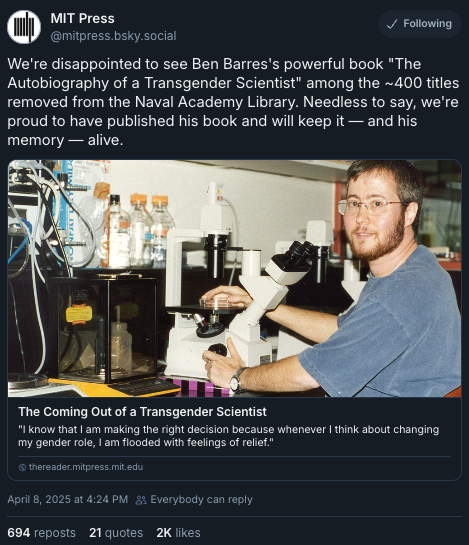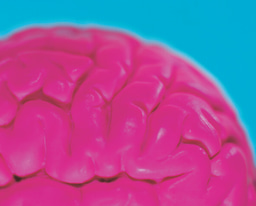Some resources for an empowered Pride
Published in Materials, Biomedical Research, and Behavioural Sciences & Psychology

Some of the hurdles scientists can face are about identity. For transgender scientists, hurdles can loom particularly large.
For a piece in Nature Methods, 'Their personal paths in science,' I interviewed scientists who identify as transgender and I spoke to some allies of transgender researchers, too. Some of what I heard was painful but I am hoping overall that the message these working scientists offer is one of empowered Pride about sciencing while trans.
The story is here and here is a quasi-open access link. As usual there is much more to say on this topic and here are some additional resources. I am happy to add more.
One of my interviewees in the piece is Dr. Megan Povey of the University of Leeds.

In this article about her research ‘You are what you eat’ as a food physics scientist, Povey talks about her work in food physics, also her identity and what it was like to go public with her transition.
“Transitioning involves stopping being afraid of the person you really are and start to be honest about your whole personality. For me that step was massively intellectually liberating. I described my past as having a gender policeman in my head, always on alert to atop any betrayal of my true personality.
Another person in the story is Dr. Winston Hirschler Dredge, postdoctoral researcher in the Hamazaki and Sakaue labs at the University of Washington.

Here are some other news pieces and general resources:
Udesky, L. Trans researchers under attack
Chen, S. Coming out at work: transgender scientists share their stories
Chen, S. The lost data: how AI systems censor LGBTQ+ content in the name of safety
Marx, V . Their personal paths in science also here
Interview with Dr. Adam Armada-Moreira, who was then a postdoctoral fellow at Linköping University in Sweden, and Ave Bisesi, who was then a PhD student at the University of Minnesota, to celebrate Transgender Day of Visibility 2022. Communications Biology
…How do you think STEM could better promote inclusive research environments and support transgender scientists?
Adam Armada-Moreira: I think the most pressing issue in STEM regarding transgender scientists is the struggle to change our names in previous publications. This has affected me a lot. … Considering that violence against transgender people is still a sad widespread reality, this refusal to protect transgender scientists can lead to tragic ends. Given this, there should be more awareness in STEM about the struggles that are specific to transgender scientists, in order to create a bigger support network.
Ave Bisesi: “Departments and institutions should offer health insurance plans that provide coverage for gender-affirming care. For PhD students in particular, low stipends can be a barrier for trans people who are saving for expensive gender-affirming surgeries or who may not have any familial financial support….. Beyond that, I really believe that a lot of the work of inclusivity is interpersonal and proactive. Every lab and department should take the time to stop and consider what changes need to be made to the way they do things in order for a trans person to feel comfortable. “
Interview with Leland Graber, then a graduate student at the University of Minnesota and Dr. Ezra Kottler a postdoctoral fellow at the University of Colorado Boulder to celebrate Transgender Day of Visibility 2023, Communications Biology
Ezra Kottler: There are a lot of unique safety concerns for transgender field scientists as they travel to and work in remote areas. Last year I founded the Trans & Gender-nonconforming Field Alliance, and together we are working to create resources for allies and for fellow transgender field scientists to support their safety and well-being in field research.
Leland Graber: In biology, specifically, I strongly believe that the ways we teach students about sex and gender, even at the K-12 level, can make a big difference in the public opinion of transgender people. …If educators taught their students about the myriad of ways organisms reproduce instead of focusing on just one or two examples, I think it would have a lot of potential to change the ways people think about human sexual behavior and gender expression.
Sapsed-Foster, I. Intersecting Identities, Shared Struggles: Black LGBTQIA+ Voices in the Fight for Health Equity (SDG 3)
A podcast and Q&A with Chima Mmeje and Tommy Gough
Here are some additional resources:
A video: The science of being transgender
The Trevor Project This organization is a social services network and offers services such as crisis intervention particularly for people aged 13-24. It runs a suicide hotline. This page is about being an ally to transgender and nonbinary young people. Here is a Trevor Project page of research briefs and reports
Some papers
Aghi, K. et al Rigorous science demands support of transgender scientists
Trans scientists report higher rates of gendered harassment in the STEMM workplace compared to their cis peers. This leads to worsened mental health consequences, decreased self-efficacy, increased attrition, and lower rates of productivity. While data collection on how these conditions affect trans populations is limited, in 2022, transgender adults in the United States lost jobs at three times the rate of cis men. Experiencing gendered harassment or remaining closeted to avoid it can have detrimental effects on trans people’s mental and physical health.
-
Bonato, M et al. Review of mobile health apps for transgender and gender diverse individuals
Condray, C.D. et al Consequences of bathroom restriction on transgender individuals with gastrointestinal conditions in the United States
Chen, D. et al. Psychosocial functioning in transgender youth after 2 years of hormones.
Gregor, R. et al. Building a queer- and trans-inclusive microbiology conference
Hanshaw. B.D. et al. A roadmap for engagement and inclusion of LGBTQIA+ people in clinical research
Kamran, M and Jennings, L. Fieldwork and LGBTQ+ Identities: Queering the Outdoors
Matsick, Jes et al. A social ecological approach to belonging in LGBTQ+ people.
At the individual level, belonging among LGBTQ+ people is influenced by various psychological factors and social identities that vary from person to person, reflecting the diverse nature of LGBTQ+ people as a group. At the interpersonal level, the close relationships of LGBTQ+ people substantially impact belonging, with family and peers having strong roles in belonging across the lifespan. Community factors of belonging emerge from the inclusive and supportive groups that LGBTQ+ individuals associate with, and LGBTQ+-affirming norms, laws and policies create conditions that bolster a sense of belonging for LGBTQ+ people. Throughout our review of each level, we identified knowledge gaps and strategies for strengthening belonging.
Cooney, R. Taking the initiative: improving LGBT+ mental health through science
Milionis, C. What is the best approach to removing the social stigma from the diagnosis of gender dysphoria?
Ken C. Pang . A physician-scientist with a pediatric practice that focuses on caring for transgender children and youth.
Sinott-Armstrong et al. Protect transgender scientists
Anticipatory obedience (3, 4), and even passive allyship, is insufficient; institutions must abandon neutrality and defend targeted communities to minimize further harm (5, 6). As queer and TGnC scientists, we call on researchers at all levels—from undergraduates to university presidents—to take direct, consistent, and rapid action.
Note: TGnC stands for transgender and non-conforming
Institutions must support TGnC and other marginalized scientists by securing their safety and privacy; their access to legal aid and health care; and their opportunities in education, employment, and society.
Tebbe, E; Budge. S. Factors that drive mental health disparities and promote well-being in transgender and nonbinary people
Weissman, J.L Queer- and trans-inclusive faculty hiring—A call for change
Running an inclusive faculty search begins long before a job is posted and includes carefully selecting committee members, deciding on the values and goals of the search committee, training the committee, crafting the language of the job advertisement, and ensuring best practices for inclusive data collection and storage, among other considerations. As the search progresses, special attention should be paid to how candidates are evaluated, including through the use ofstandardized rubrics. Providing accessible infrastructure for candidates during visits is a must, especially on stressful interview days.
-
Resources – a few of many
- A college guide for nonbinary and transgender students
- Here is a guide on Student Space, which is connected to the UK’s student mental health charity
- Here is reading list from Parents, Families and Friends of Lesbians and Gays (PFLAG)
- University of California San Francisco LGBTQ Resource center
- University of Minnesota Gender and Sexuality Center for Queer and Trans Life
- University of Chicago Center for Identity + Inclusion
- Harvard University Office of BGLTQ affairs
- University of Mississippi LGBTQIA Affairs Committee
- INSEAD Teaching Out LGBT Fellowship
- Queer representation at LMU Munich
-
Books
Darwin, H. Redoing Gender: How Nonbinary Gender Contributes Toward Social Change.
A book based on interviews with 47 nonbinary people shows that it is challenging to be anything other than a man or a woman in a society that selectively acknowledges those two genders.
Ben Barres The Autobiography of a transgender scientist
Ben Barres was a neurobiologist who discovered that glial cells release factors that help make synaptic connections between neurons. He was the first openly transgender member elected to the American National Academy of Sciences, among numerous other honours. He died in 2017 from pancreatic cancer.
Excerpt from The Autobiography of a Transgender Scientist
“I lived life on my terms: I wanted to switch genders, and I did. I wanted to be a scientist, and I was. I wanted to study glia, and I did that too. I stood up for what I believed in and I like to think I made an impact, or at least opened the door for the impact to occur. I have zero regrets and I’m ready to die. I’ve truly had a great life.”
Haimson, O. Trans Technologies MIT Press "Trans Technologies describes what happens when trans people take technology design into their own hands. " And here is a podcast discussion with Oliver L. Haimson
-
From Lori Gross at Rehab.com here are other resources.
A few of the ones listed are:
The LGBT National Hotline 1-888-843-4564 The U.S. hotline gives confidential advice such as on sexual orientation or gender identity/ expression challenges. It's staffed with LGBTQIA+ volunteers.
Advocates for Trans Equality is an U.S. based non-profit advocacy organization.
Trans Lifeline is a peer support non-profit group.
PFLAG is an organization in the US that supports, educates and advocates for LGBTQ+ people and those who love them.
The Transgender Law Center offers many types of legal resources related to transgender life in the U.S.
Pride Institute has resources and information about addiction treatment tailored to the LGBTQ+ community.
The Association of Lesbian, Gay, Bisexual, Transgender Addiction and their Allies is a US organization helps to prevent and treat alcoholism, substance use and other addictions in the LGBTQ+ communities

(Credit: RA Kearton, Getty Images)






Please sign in or register for FREE
If you are a registered user on Research Communities by Springer Nature, please sign in